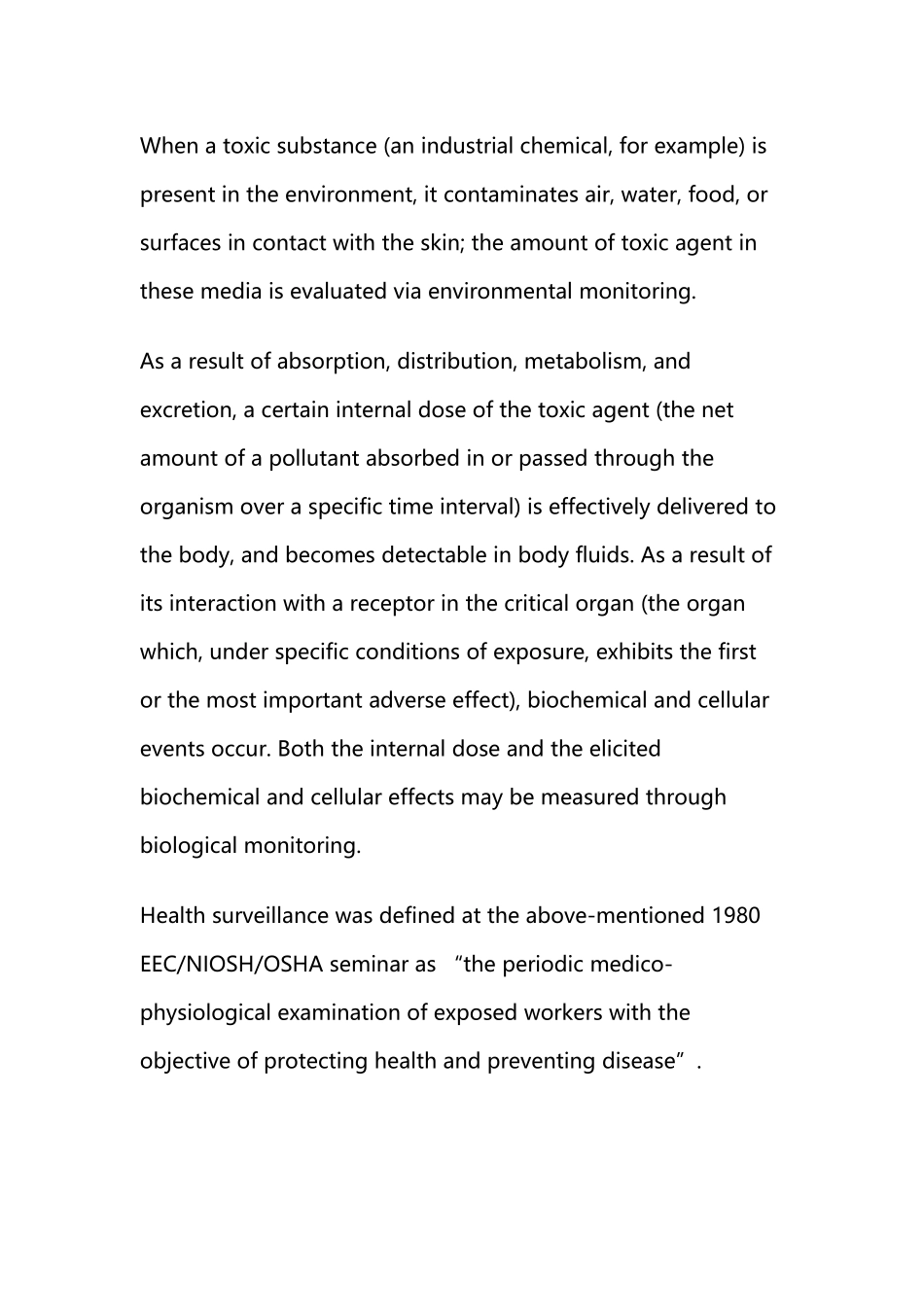Chapter27-BiologicalMonitoringGENERALPRINCIPLESVitoFoàandLorenzoAlessioBasicConceptsandDefinitionsAttheworksite,industrialhygienemethodologiescanmeasureandcontrolonlyairbornechemicals,whileotheraspectsoftheproblemofpossibleharmfulagentsintheenvironmentofworkers,suchasskinabsorption,ingestion,andnon-work-relatedexposure,remainundetectedandthereforeuncontrolled.Biologicalmonitoringhelpsfillthisgap.Biologicalmonitoringwasdefinedina1980seminar,jointlysponsoredbytheEuropeanEconomicCommunity(EEC),NationalInstituteforOccupationalSafetyandHealth(NIOSH)andOccupationalSafetyandHealthAssociation(OSHA)(Berlin,YodaikenandHenman1984)inLuxembourgas“themeasurementandassessmentofagentsortheirmetaboliteseitherintissues,secreta,excreta,expiredairoranycombinationofthesetoevaluateexposureandhealthriskcomparedtoanappropriatereference”.Monitoringisarepetitive,regularandpreventiveactivitydesignedtolead,ifnecessary,tocorrectiveactions;itshouldnotbeconfusedwithdiagnosticprocedures.Biologicalmonitoringisoneofthethreeimportanttoolsinthepreventionofdiseasesduetotoxicagentsinthegeneraloroccupationalenvironment,theothertwobeingenvironmentalmonitoringandhealthsurveillance.Thesequenceinthepossibledevelopmentofsuchdiseasemaybeschematicallyrepresentedasfollows:source-exposedchemicalagent—internaldose—biochemicalorcellulareffect(reversible)—healtheffects—disease.Therelationshipsamongenvironmental,biological,andexposuremonitoring,andhealthsurveillance,areshowninfigure27.1.Figure27.1Therelationshipbetweenenvironmental,biologicalandexposuremonitoring,andhealthsurveillanceWhenatoxicsubstance(anindustrialchemical,forexample)ispresentintheenvironment,itcontaminatesair,water,food,orsurfacesincontactwiththeskin;theamountoftoxicagentinthesemediaisevaluatedviaenvironmentalmonitoring.Asaresultofabsorption,distribution,metabolism,andexcretion,acertaininternaldoseofthetoxicagent(thenetamountofapollutantabsorbedinorpassedthroughtheorganismoveraspecifictimeinterval)iseffectivelydeliveredtothebody,andbecomesdetectableinbodyfluids.Asaresultofitsinteractionwithareceptorinthecriticalorgan(theorganwhich,underspecificconditionsofexposure,exhibitsthefirstorthemostimportantadverseeffect),biochemicalandcellulareventsoccur.Boththeinternaldoseandtheelicitedbiochemicalandcellulareffectsmaybemeasuredthroughbiologicalmonitoring.Healthsurveillancewasdefinedattheabove-mentioned1980EEC/NIOSH/OSHAseminaras“theperiodicmedico-physiologicalexaminationofexposedworkerswiththeobjectiveofprotectinghealthandpreventingdisease”.Biologicalmonitoringandhealthsurveillancearepartsofacontinuumthatcanrangefromthemeasurementofagentsortheirmetabolitesinthebodyviaevaluationofbiochemicalandcellulareffects,tothedetectionofsignsofearlyreversibleimpairmentofthecriticalorgan.Thedetectionofestablisheddiseaseisoutsidethescopeoftheseevaluations.GoalsofBiologicalMonitoringBiologicalmonitoringcanbedividedinto(a)monitoringofexposure,and(b)monitoringofeffect,forwhichindicatorsofinternaldoseandofeffectareusedrespectively.Thepurposeofbiologicalmonitoringofexposureistoassesshealthriskthroughtheevaluationofinternaldose,achievinganestimateofthebiologicallyactivebodyburdenofthechemicalinquestion.Itsrationaleistoensurethatworkerexposuredoesnotreachlevelscapableofelicitingadverseeffects.Aneffectistermed“adverse”ifthereisanimpairmentoffunctionalcapacity,adecreasedab...



 优质VIP
优质VIP 优质VIP
优质VIP 优质VIP
优质VIP 优质VIP
优质VIP 优质VIP
优质VIP 优质VIP
优质VIP 优质VIP
优质VIP 优质VIP
优质VIP 优质VIP
优质VIP 优质VIP
优质VIP